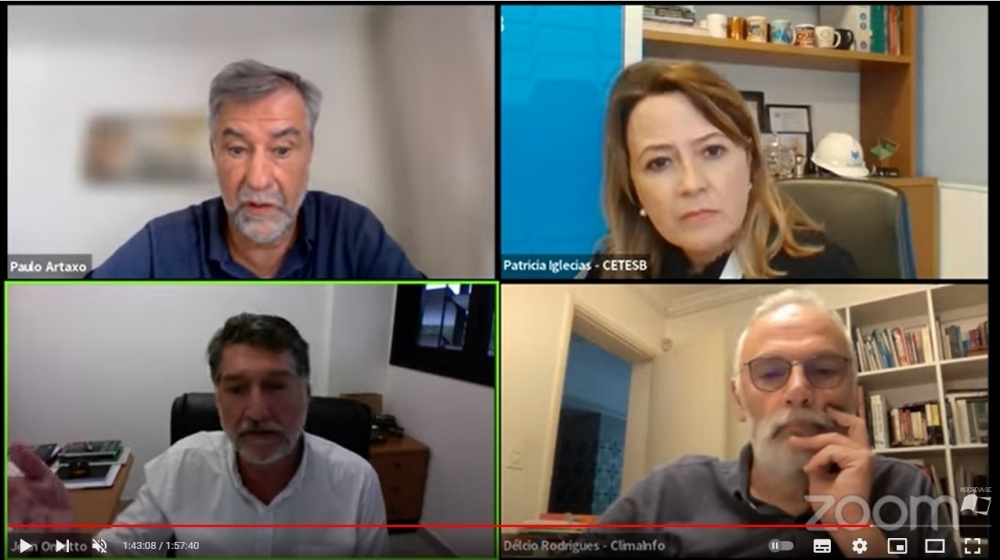


The initiative was one of the few advances achieved at the 27th United Nations Climate Change Conference held in November, according to the participants in a webinar hosted by FAPESP (image: screenshot taken during the webinar)
Published on 01/02/2023
By Elton Alisson | Agência FAPESP – The creation of a global fund to address loss and damage in vulnerable countries hit hard by climate disasters, announced at the end of the 27th United Nations Climate Change Conference (COP27), was one of the few advances won at the meeting held in November 2022 in Egypt.
The loss and damage fund exists only on paper. Who will contribute, and how much, has yet to be decided. Nevertheless, the initiative is without precedent and should give a boost to the climate justice movement, which seeks reparation for the loss and damage suffered by the populations of poor countries. These emit the least amount of the greenhouse gases that cause global warming but are the hardest hit by the adverse effects of climate change, such as drought and extreme weather.
This was the main thrust of the views expressed by the participants in a webinar on Ways Forward for Brazil Post-COP27 held by the FAPESP Research Program on Global Climate Change (RPGCC) on November 30, 2022, to analyze the issues that most stood out at COP27 and discuss how Brazil should implement its new climate agenda.
“You hear a lot about mitigation of greenhouse gas emissions and climate change adaptation, but the question of loss and damage funding for the poorest countries is much more relevant to what’s happening now,” said Délcio Rodrigues, CEO of Instituto Climainfo. “Countries like Mozambique or Pakistan, which have recently suffered such severe flooding, have already lost a significant proportion of GDP [gross domestic product] and past investments owing to climate change. They and other countries have long demanded a big enough fund to rebuild areas devastated by extreme weather events, but until now this demand had never even been put on the table.”
One of the obstacles to the creation of a global loss and damage fund was concern on the part of rich countries that this could be construed as blaming them for the ill effects of climate change. They feared being made legally and financially liable for loss and damage reparation. To avoid blame, the United States and others insisted at COP27 that they would only sign up to a humanitarian mechanism involving financial compensation for losses caused by extreme weather to the poorest countries, and would not accept legal or financial liability.
“Establishment of the fund is a step forward. The next step requires working out where the money will come from and how it can be used effectively by the countries that genuinely need it, all of which raises the idea of climate justice. However, we don’t need litigation to get results,” said Patricia Iglecias, CEO of CETESB, the Environmental Company of São Paulo, and a professor at the University of São Paulo’s Law School (FD-USP).
Expectations frustrated
COP27’s failure to reach agreement on the phasing out of all fossil fuels, the main cause of climate change, was a major frustration, Rodrigues said. COP26, held in October 2021 in Glasgow, Scotland, agreed for the first time to phase out the use of coal, and there were great expectations for a similar deal on other fossil fuels at COP27, but these hopes proved vain.
“We expected at least an agreement on a so-called “phase down” of all fossil fuels, but it didn’t materialize. One reason may have been the presence of more than 600 oil, gas and coal industry lobbyists at the conference,” Rodrigues said.
Another frustration, according to the webinar participants, was failure to include in the cover decision, or final text, a commitment to limiting global warming to 1.5 °C by cutting greenhouse gas emissions.
To achieve this goal, global emissions of carbon dioxide (CO2) must not rise by more than 380 gigatons (Gt) between now and 2040, but annual emissions currently exceed 42 Gt and projections for this year point to a rise of 1%-2% compared with 2021, according to Jean Ometto, a scientist at the National Space Research Institute (INPE).
“We have less than eight years to slash carbon emissions if global warming is to be limited to 1.5 °C. It’s a huge challenge,” Ometto said.
Subnational governments (states and cities) can play a key role in cutting greenhouse gas emissions, according to Gilberto Jannuzzi, a professor at the State University of Campinas (UNICAMP). To this end, a group of Brazilian states comprising São Paulo, Minas Gerais, Espírito Santo and Pernambuco is preparing development plans that will include mitigation measures.
São Paulo’s Climate Action and Sustainable Development Plan 2050 calls for a 12% reduction in greenhouse gas emissions in the state by 2030 compared with 2021.
“This represents a major challenge. São Paulo will probably have to consider cutting its emissions in other parts of Brazil to achieve this target,” Jannuzzi said.
To help São Paulo and all of Brazil achieve their mitigation goals, FAPESP has issued a call for research proposals to accelerate the energy transition. Applications for funding under the call must be submitted by January 27, 2023.
“Global climate change is a concern because the consequences will be very disruptive. The impact for a person who lives in or around Santos [a major port city on the coast of São Paulo state] may be different compared to elsewhere, just as it will be different for agriculture and the service sector. For this reason, we need to take all economic sectors and interests into account in order to reach a proposal that represents a consensus. That’s what happened at COP27,” Luiz Eugênio Mello, FAPESP’s Scientific Director, said in his opening address to the event.
A recording of the webinar on Ways Forward for Brazil Post-COP27 can be watched at: youtube.com/watch?v=254oqRpb-vk.
Source: https://agencia.fapesp.br/40386